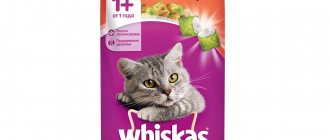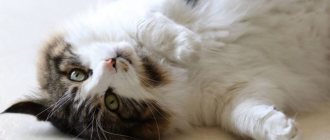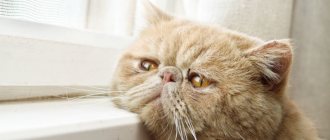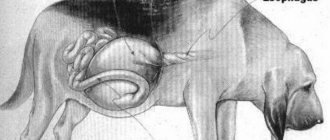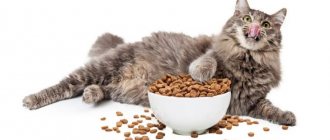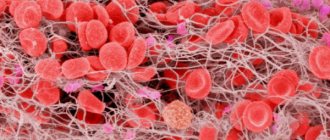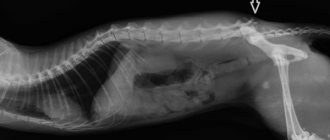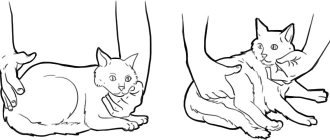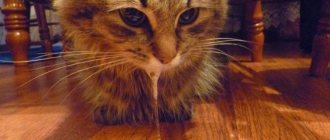Heart pathologies in cats are classified as diseases of older age. The most common cardiomyopathies are myocardial lesions characterized by an increase in the size of the heart muscle. Of several varieties, hypertrophic cardiomyopathy (HCM) is most often diagnosed - isolated myocardial damage with hypertrophy (thickening) of the ventricular walls. Dilated cardiomyopathy (DCM) is also common, in which there is a pathological enlargement (dilatation) of the heart chambers. The insidiousness of this disease is that it may not make itself known for a long time, suddenly attacking the pet with the full severity of the symptoms. Therefore, the owner needs to be especially careful not to miss the first signs of a developing illness in his pet.
Feline heart disease
Pathologies occur both congenital and acquired. All existing diseases are classified according to location and cause of occurrence:
- Heart defects.
- Tissue mutations.
- Disorders of heart rhythm and conduction of electrical impulses.
- Parasitic origin.
- Inflammatory. They develop in organ tissues. The following diseases are distinguished by location:
- pericarditis;
- myocarditis;
- endocarditis.
Among these problems, cardiomyopathy develops most often in cats.
Structure of a cat's heart
Cardiomyopathy: etiology and pathogenesis
Feline hypertrophic cardiomyopathy (HCM) is a pathology accompanied by hardening of the walls of the ventricle. As the disease develops, the volume of the heart chambers is significantly reduced, subsequently provoking heart failure. Timely treatment helps prevent death, but in advanced forms of the disease the prognosis is poor. The disease mainly manifests itself early in the pet's life - at the age of 6 months.
Animals with genetic heart abnormalities do not survive to puberty
HCM is considered a relatively new disease. Research into this pathology was actively carried out at the beginning of the last decade in the USA.
Scientists have concluded that breeds most susceptible to the disease include Ragdoll, Sphynx , Norwegian Forest, Scottish Fold , Persian and Abyssinian breeds. In Maine Coons, transmission of the disease at the genetic level has been confirmed. Most often the disease is observed in males.
The most susceptible breeds to the disease
Among such mass-bred breeds as Siamese , British Shorthair , Siberian and Russian Blue, no hereditary predisposition has been identified. Representatives of these varieties suffer from secondary forms of pathology.
What happens to the heart with HCM?
The clinical picture of a typical cardiomyopathy is characterized by the following manifestations:
- Reduction in the size of the left ventricle, which can lead to a decrease in the amount of blood supplied. In addition, the mobility of the walls decreases. This leads to the release of blood into the vessels of the lungs.
- As the disease progresses, the left atrium enlarges. The resulting blood clots contribute to impaired hemostasis, leading to paralysis of the hind limbs.
- Further, the mitral valve is involved in the pathological process. As a result of a change in its location, an obstruction occurs in the exit of blood into the aorta. This hitch in the blood flow is accompanied by a systolic murmur.
- Myocardial compaction causes blood stagnation in the atria and malfunction of the atrioventricular valve. As a result, aortic obstruction and circulatory deficiency are noted.
Image of a heart affected by pathology
Types of HCM
Hypertrophic cardiomyopathy of furry pets is divided into 2 types: primary and secondary. The origin of the first type, which occurs in obstructive and non-obstructive forms, is currently under study. The second (acquired) develops under the influence of another disease.
Table 1. Types of HCM in cats
| Type | Characteristic |
| Obstructive | Due to the expansion of the myocardium, the pressure in the left ventricle increases, which increases the rate of blood flow into the aorta. As a result, the bicuspid valve leaf opens and closes involuntarily |
| Non-obstructive | The mechanism of manifestation of the pathology is identical to the previous one, except that high blood flow speed does not affect the functioning of the valve |
| Acquired | It is provoked by existing diseases and age-related transformations, accompanied by mutations in the structure of the myocardium. Infectious pathologies, disruptions in the endocrine system, injuries and toxins are the triggering factors. |
The primary type of the disease, which is characterized by genetic origin, manifests itself before 5 years. The secondary form occurs mainly in older cats after 7 years.
The secondary form of the disease occurs in adult cats
Possible complications
The progression of hypertrophic cardiomyopathy affects all parts of the heart and the circulatory system as a whole. This occurs due to the overcrowding of the lung vessels with blood. Due to slow blood circulation in the cat's heart chambers, blood clots form.
The danger of HCM is the formation of blood clots
What happens to a cat’s heart during pathology?
Disturbances in the functioning of the heart muscle begin after certain morphological changes occur in the organ. With the development of hypertrophic cardiomyopathy, the left ventricle and interventricular septum are primarily affected by pathological destruction.
A defective gene results in the body being unable to produce a sufficient amount of a specific protein - myosin, which is the basis of the myocardium. The body begins to compensate for the lack of muscle fibers with connective tissue. The myocardial wall thickens. The organ seems to be scarring.
Thickening of the myocardial wall leads to a decrease in the volume of the left ventricle, and often the left atrium. In addition, connective tissue reduces the elasticity and extensibility of the heart. The pumping function of the organ weakens.
Thickening of the myocardium leads to the fact that blood stagnates in the atria and the functioning of the atrioventricular valve is disrupted. Aortic obstruction occurs and circulatory deficiency occurs.
The development of hypertrophic cardiomyopathy affects all parts of the heart and affects the blood circulation of the body as a whole. This is explained by the fact that a spasm of the peripheral bloodstream occurs, and the pulmonary vessels become overfilled with blood. In a sick animal, blood clots form due to slow blood flow in the distended chambers of the heart.
Symptoms of the disease
The main manifestations of hypertrophic cardiomyopathy are poor exercise tolerance and shortness of breath. If the disease is asymptomatic, there is a high probability of death due to thromboembolism, which develops as a result of pulmonary edema.
Dyspnea and paralysis are common in HCM
The main signs of HCM are the following symptoms:
- Physical state. An exhausted animal loses interest in active games and sleeps a lot.
- Breath. Severe, accompanied by wheezing and gurgling. Under heavy load, the pet experiences difficulty in inhaling. This is caused by slowing down the movement of blood in the veins. The cat breathes with its belly, sticking out its tongue.
- Dyspnea. Attacks of suffocation often lead to fainting as a result of lack of oxygen.
- Character of the pulse. Filiform.
- Condition of mucous membranes. Due to oxygen starvation, the shells acquire a blue tint.
- Cough. Reflex, caused by excessive pressure of an enlarged heart on the trachea. To cope with an attack, the cat sticks out its neck, spreading its forelimbs for greater ventilation.
- Hydrothorax and ascites. The release of exudate contributes to the formation of swelling in the peritoneum and chest.
- Paralysis of the hind limbs. If a blood clot blocks the lumen in the vessels, the animal’s legs in the pelvic area fail.
- Body mass . Poor weight gain.
- Heart murmurs and tachycardia.
If you notice any of the symptoms, take your pet to the veterinarian
Information about the disease
Feline hypertrophic cardiomyopathy (HCM) is a serious pathology that causes changes in the volume of the heart muscles. An increase in the size of the cardiac muscles and cardiac septum leads to detrimental changes in work: with each contracting movement of the muscle, a smaller volume of blood enters the heart - the overall speed of blood flow decreases, the blood supply to each organ is disrupted, and there is a risk of blood clots.
This disease is quite dangerous, because such disturbances in the functioning of the myocardium lead to arterial thromboembolism, heart failure, and sudden death.
According to many data, primary HCM occurs due to mutations in the DNA gene, which has a significant effect on the synthesis of proteins, which play a role in the contractile function of the myocardium.
If the pathology occurs not due to a hereditary factor, but due to age-related changes or due to other concomitant ailments, then HCM is called secondary (acquired). The problem can become apparent during the cat’s life due to previous endocrine or infectious diseases, as well as due to mechanical damage and the toxic effects of toxic compounds.
Reasons for the development of the disease
The main cause of the disease is considered to be a gene mutation. The pathology is inherited among some cat breeds. American experts concluded that the gene responsible for myosin binding protein is to blame. Maine Coons and Ragdolls are predominantly affected by this gene mutation. It has been proven that more than 10 genes are involved in the development of the disease.
Representatives of the Maine Coon breed are more susceptible to pathology than others
In addition to breed predisposition, a number of other reasons influence the development of cardiomyopathy.
Table 2. Provoking factors
| Provoking factor | Characteristic |
| Congenital myocardial pathologies | Any diseases occurring in this part of the heart are fraught with hardening of its walls |
| Infusion therapy | If the rate of intravenous penetration of the drug into the pet’s body does not correspond to its physiology, the pressure in the vessels increases. As a result, stagnation occurs, leading to swelling of the lungs. Insufficient oxygen supply leads to hypoxia |
| Malignant neoplasms | The formation of lymphoma is fraught with mutation of the myocardial structure |
| Endocrine diseases | Increased activity of the thyroid gland contributes to the development of tachycardia. Due to increased production of growth hormone, the walls of the heart muscle thicken |
| Taurine deficiency | This amino acid, essential for cats, regulates organ contractility, has an anti-ischemic effect and maintains the integrity of cell membranes. Deficiency of this element destabilizes the heart muscle |
| Application of anesthesia | Pets may develop hypertrophic cardiomyopathy after being under general anesthesia. The disease manifests itself either immediately or several days after artificial immersion in sleep |
| Chronic intoxication | Overdose of medications, chemical poisoning, products of pathogenic activity of parasites negatively affect the fibers of the heart muscle and contribute to the development of ventricular hypertrophy |
| High blood pressure | Constant deviation from the norm provokes wear and tear of the organ |
Types of cardiomyopathy
Veterinarians distinguish the following types of disease:
- Hypertrophic cardiomyopathy resulting from thickening of the heart walls. In this case, the muscle processes less blood, which leads to a decrease in oxygen supply to vital organs. This type of cardiomyopathy is the most common.
- Dilated cardiomyopathy, in which the volume of the heart greatly increases while maintaining the thickness of its walls. As a result, the heart is unable to contract at its normal volume, causing the liver, brain and other organs to experience oxygen starvation.
- Restrictive cardiomyopathy due to liver fibrosis, in which the heart hardens and cannot pump as well as before. As a result, the pet's life expectancy is sharply reduced (up to 2 years).
Diagnosis of the disease
The difficulty of detection is caused by the hidden nature of the pathology. Malfunctions in the functioning of the organ can be detected by listening to heart murmurs. In the presence of HCM, they resemble a gallop.
An echocardiogram is considered the most informative way to diagnose HCM
Basic methods:
- Anamnesis collection. The owner must describe the pet's condition in detail. Any deviation in behavior may signal the development of the disease.
- Echocardiography is the most accurate diagnostic method. It makes it possible to thoroughly study the structure of the heart muscle. Each cat that is at risk by breed should be examined at least once a year. Before surgery that involves the use of anesthesia, it is also necessary to check for the presence of HCM.
- Electrocardiography. This survey is not informative enough. It can be used to detect tachycardia, ventricular arrhythmia and widening of the QRS interval. However, it is not used as an independent method for diagnosing pathology.
- X-ray diagnostics. The shape and size of the heart muscle, as well as the presence of fluid in the pleural cavity, are assessed.
- Auscultation. Listening allows you to identify extraneous noise and evaluate your heart rhythm.
- Pressure measurement. With HCM, blood pressure will be elevated.
- Visual assessment. Blue discoloration of the mucous membranes indicates a malfunction of the heart muscle.
Pressure measurement is an auxiliary diagnostic method
If the animal has a severe form of hypertrophic cardiomyopathy, hardware examinations are not performed. Any manipulation negatively affects the emotional state of the pet and increases the manifestation of unpleasant symptoms.
Treatment of the disease
The developed treatment regimens for pathology do not make it possible to completely overcome the disease. The main emphasis is on symptomatic therapy. In severe cases, in addition to medication, special equipment is used.
Hospital treatment
The duration of stay in the clinic is 3 days. Any hardware intervention is carried out as carefully as possible in relation to the animal. Basic procedures:
- To stabilize the condition, the animal is placed in an oxygen box, which is a chamber with a constant supply of oxygen.
- After you feel better, if necessary, the fluid accumulated in the pleura is removed (thoracentesis). This helps ease the breathing process.
While in the clinic, owners are allowed to visit their pets. Such visits speed up the healing process.
One of the methods of express therapy is thoracentesis.
Drug treatment
Therapy is based on stabilizing the heart rate, preventing the formation of blood clots and relieving pulmonary edema.
Drugs used:
- Beta blockers. "Verapamil" and "Carvedilol". Reduces the load on the heart.
- Thrombolytics. "Alteplase". Blood clots dissolve.
- Antiplatelet agents. Heparin and Aspirin. Prevents the formation of blood clots.
- Diuretics. "Temisal", "Eufillin" and "Furosemide". Reduce congestion and eliminate swelling.
- Taurine-containing preparations. Thin the blood and improve the condition of blood vessels. Vitamins for cats from, GimP.
Beta blocker "Verapamil" has a positive effect on cardiac tone
For older pets suffering from secondary hypertrophic cardiomyopathy, the root cause is eliminated. Animals must be registered with a veterinarian and undergo regular examinations.
The dosage is prescribed by the doctor, based on the degree of organ damage.
Diet food
In addition to taking medications, the cat is put on a special diet that helps stabilize blood pressure. It is based on avoiding salt. This substance promotes fluid retention.
It is important to enrich the nutrition plan with the following elements:
- taurine;
- fatty acid;
- L-carnitine.
If there is a lack of vitamins, food supplements are given, sold in veterinary pharmacies.
Therapeutic diet involves avoiding salt intake
If before the onset of HCM the diet consisted of dry food, it is necessary to switch the animal to food designed for pets with pathologies of the cardiovascular system.
During treatment, the animal should not be overfed, since obesity contributes to the formation of additional stress on the heart.
Excess weight negatively affects the functioning of the heart muscle
Treatment of hypertrophic cardiomyopathy in cats
Therapy for this pathology is aimed primarily at reducing congestion, regulating heart rate, preventing pulmonary edema and preventing the formation of blood clots.
If hydrothorax is detected in a sick cat, a puncture of the chest is performed in a specialized clinic in order to pump out the pleural effusion. Furosemide is used parenterally to reduce congestion and eliminate edema. The dosage and frequency of use is determined by a veterinarian based on an echocardiographic examination of the diseased organ.
Beta blockers have a good effect in the treatment of hypertrophic cardiomyopathy in cats. The drugs reduce heart rate and suppress tachyarrhythmias. Beta blockers reduce myocardial oxygen demand and fibrosis in the organ.
In the treatment of the disease, calcium channel blockers are used, for example, Diltiazem, Delacor, Cardizem. The drugs reduce the heart rate and have a positive effect on the relaxation of the heart muscle.
In addition to complex therapy, maintenance and nutrition play an important role in the treatment of sick animals. A sick cat should be protected from stressful situations and given rest. The diet should be balanced primarily in terms of taurine content. On the recommendation of a veterinarian, the animal can be given the amino acid orally.
Taurine for cats
Disease prognosis
The disease development scenario is determined by the following factors:
- timely detection of the disease;
- degree of severity of symptoms;
- the presence of swelling and thromboembolism.
If the pathology is detected at an early stage, subject to proper nutrition and well-chosen therapy, the prognosis is favorable. Life expectancy is not reduced. If left untreated, the pet dies. Death occurs due to thrombosis or heart failure.
Stress can make your pet's condition worse
It is important to remember that any stress can worsen a pet’s physical condition. Therefore, it is necessary to protect the animal from emotional stress.
Prevention of HCM
The leading preventive direction is early diagnosis. Your pet should be brought in regularly for examination using echocardiography. You should also enrich the animal’s diet with proteins and taurine.
Cats suffering from cardiomyopathy do not participate in breeding.
Timely diagnosis of the disease is the best preventive measure
Hypertrophic cardiomyopathy is a common pathology among cats. Maine Coons and Ragdolls are more susceptible to the disease. Therefore, owners of representatives of these breeds should be extremely attentive to the physical condition of the pet.
Proper nutrition
Heart problems inevitably lead to a complete revision of the animal’s diet. Especially if the disease is already at a severe stage and medical treatment is underway.
It is important to select special foods, as well as supplements that contain the necessary vitamins and minerals. The most suitable supplements, which are often prescribed by specialists, are Amaranth or Active Pet.
It is preferable to make up your pet’s diet from the products presented below:
- boiled chicken breast;
- chicken by-products, which are also pre-boiled (for convenience, they can then be chopped);
- boiled chicken yolk, given no more than 1-2 times a week;
- cottage cheese, also no more than 2-3 times a week;
- a small amount of cheese.
The main diet should consist of cereals with a meat component. It is advisable to add additional vegetables such as carrots or cauliflower. Using dry food is possible, but only with a low salt content.
Proper nutrition

